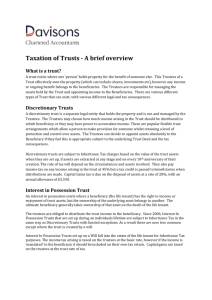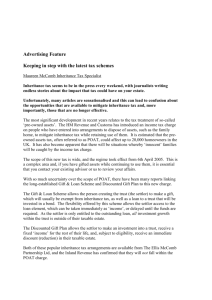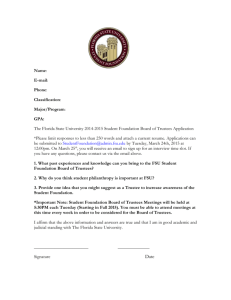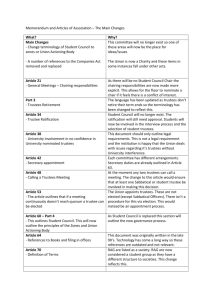Trustee Act 2000 - First Business Systems
advertisement
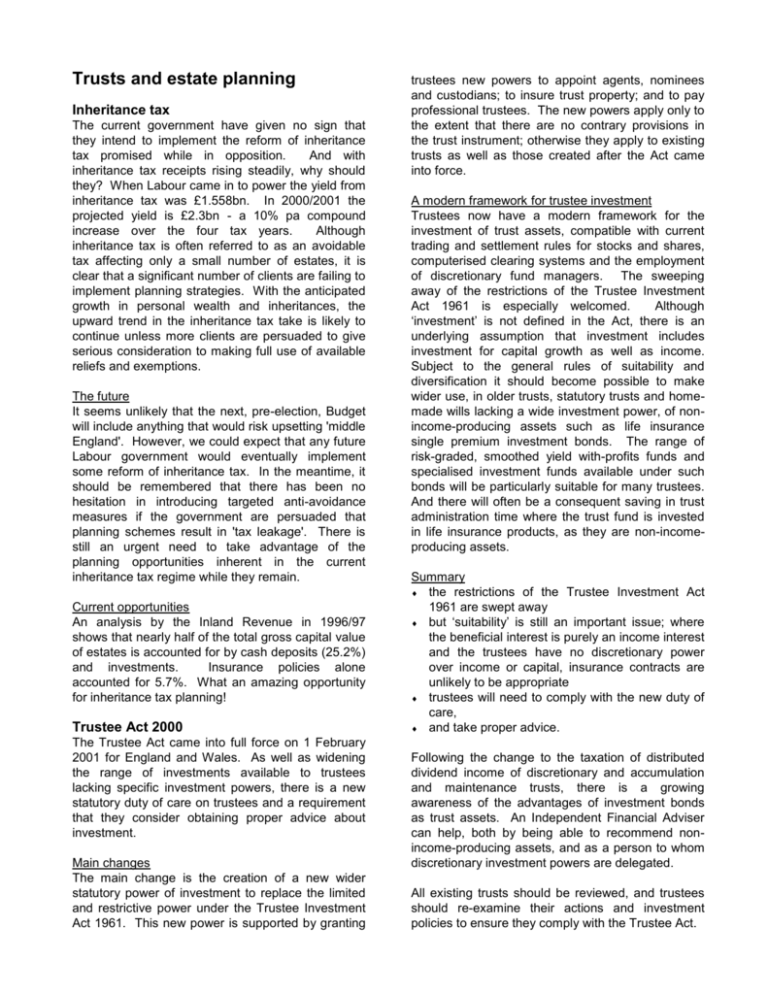
Trusts and estate planning Inheritance tax The current government have given no sign that they intend to implement the reform of inheritance tax promised while in opposition. And with inheritance tax receipts rising steadily, why should they? When Labour came in to power the yield from inheritance tax was £1.558bn. In 2000/2001 the projected yield is £2.3bn - a 10% pa compound increase over the four tax years. Although inheritance tax is often referred to as an avoidable tax affecting only a small number of estates, it is clear that a significant number of clients are failing to implement planning strategies. With the anticipated growth in personal wealth and inheritances, the upward trend in the inheritance tax take is likely to continue unless more clients are persuaded to give serious consideration to making full use of available reliefs and exemptions. The future It seems unlikely that the next, pre-election, Budget will include anything that would risk upsetting 'middle England'. However, we could expect that any future Labour government would eventually implement some reform of inheritance tax. In the meantime, it should be remembered that there has been no hesitation in introducing targeted anti-avoidance measures if the government are persuaded that planning schemes result in 'tax leakage'. There is still an urgent need to take advantage of the planning opportunities inherent in the current inheritance tax regime while they remain. Current opportunities An analysis by the Inland Revenue in 1996/97 shows that nearly half of the total gross capital value of estates is accounted for by cash deposits (25.2%) and investments. Insurance policies alone accounted for 5.7%. What an amazing opportunity for inheritance tax planning! Trustee Act 2000 The Trustee Act came into full force on 1 February 2001 for England and Wales. As well as widening the range of investments available to trustees lacking specific investment powers, there is a new statutory duty of care on trustees and a requirement that they consider obtaining proper advice about investment. Main changes The main change is the creation of a new wider statutory power of investment to replace the limited and restrictive power under the Trustee Investment Act 1961. This new power is supported by granting trustees new powers to appoint agents, nominees and custodians; to insure trust property; and to pay professional trustees. The new powers apply only to the extent that there are no contrary provisions in the trust instrument; otherwise they apply to existing trusts as well as those created after the Act came into force. A modern framework for trustee investment Trustees now have a modern framework for the investment of trust assets, compatible with current trading and settlement rules for stocks and shares, computerised clearing systems and the employment of discretionary fund managers. The sweeping away of the restrictions of the Trustee Investment Act 1961 is especially welcomed. Although ‘investment’ is not defined in the Act, there is an underlying assumption that investment includes investment for capital growth as well as income. Subject to the general rules of suitability and diversification it should become possible to make wider use, in older trusts, statutory trusts and homemade wills lacking a wide investment power, of nonincome-producing assets such as life insurance single premium investment bonds. The range of risk-graded, smoothed yield with-profits funds and specialised investment funds available under such bonds will be particularly suitable for many trustees. And there will often be a consequent saving in trust administration time where the trust fund is invested in life insurance products, as they are non-incomeproducing assets. Summary the restrictions of the Trustee Investment Act 1961 are swept away but ‘suitability’ is still an important issue; where the beneficial interest is purely an income interest and the trustees have no discretionary power over income or capital, insurance contracts are unlikely to be appropriate trustees will need to comply with the new duty of care, and take proper advice. Following the change to the taxation of distributed dividend income of discretionary and accumulation and maintenance trusts, there is a growing awareness of the advantages of investment bonds as trust assets. An Independent Financial Adviser can help, both by being able to recommend nonincome-producing assets, and as a person to whom discretionary investment powers are delegated. All existing trusts should be reviewed, and trustees should re-examine their actions and investment policies to ensure they comply with the Trustee Act. Accumulation trusts in 2001 and maintenance Accumulation and maintenance trusts enjoy a special tax status in that during the accumulation period they are discretionary trusts but are not subject to the discretionary trust tax regime. However, this special status lasts for 25 years only unless: all the beneficiaries are grandchildren of a common grandparent (i.e. of the same generation) all the beneficiaries are children, widows or widowers of grandchildren who have died before becoming entitled (exceptionally) the trust was created before 15 April 1976, the trustees had no power to bring in the common grandparent condition and the trusts have not been varied since 15 April 1976. If a trust ceases to be an accumulation and maintenance trust because there is no common grandparent and the 25-year period has run out, then there is a charge to tax at 21% unless all the trust property has been distributed or the beneficiaries obtain interests in possession. The 21% rate is arrived at by taking: 0.25% for each of the first forty quarters (10%) 0.20% for each of the next forty quarters (8%) 0.15% for each of the next twenty quarters (3%) Thereafter the normal rules for ten-yearly and proportionate charges for discretionary trusts apply to these settlements. The accumulation and maintenance regime came into being on 15 April 1976 and the 25-year period could therefore run out from 15 April 2001 onwards. An accumulation and maintenance settlement is most likely to fall foul of the common grandparent condition if, at the time the settlement was created, it was intended to provide for unborn grandchildren. For example: In 1976 Henry was a wealthy individual with two married children. He hoped to become a grandfather and wanted to set some money aside for the education of his future grandchildren. On 1 December 1976 he created an accumulation and maintenance settlement for his niece and his unborn grandchildren at age 25 with no right to income at age 18. Grandchildren were born in 1987 and 1990. If the 25-year time limit is allowed to run out on 1 December 2001 a tax charge arises. Suppose the value of the trust fund at that date is £250,000. The tax charge is then £52,500. However, if the grandchildren are given interests in possession before 1 December 2001, the tax charge is nil. It is therefore important to review all accumulation and maintenance trusts as they approach 25 years in being if the common grandparent provision does not apply. These accumulation and maintenance trusts should be terminated by appointing absolute interests or interests in possession to the beneficiaries. There are capital gains tax implications if the trust holds chargeable assets but this will not, of course, be an issue where the trust fund comprises purely life insurance policies. Every care has been taken to ensure that the information given in this document is correct and in accordance with our understanding of current law and Inland Revenue practice. The law and Inland Revenue practice are subject to change. February 2001


